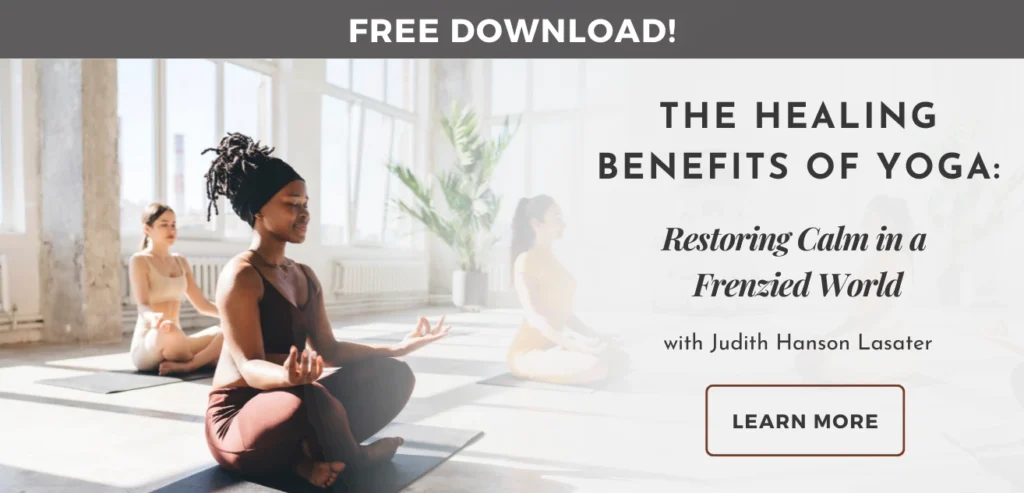Decompress in Supported Bridge Pose

Sometimes it can be a struggle to step onto your yoga mat. This is especially true if you practice in the evening. After a challenging day, it’s sometimes hard to justify practicing a bunch of sweaty vinyasas. But the good news is, yoga doesn’t have to add to your challenges. Resting in a single Restorative Yoga pose can be a powerful way to balance those jittery and/or flaccid energies. Supported Bridge Pose (Salamba Setu Bandha Sarvangasana) is the perfect pose to calm your nervous system and renew the quiet energy that yoga practice is meant to generate.
Benefits of Supported Bridge Pose

Supported Bridge Pose combines the benefits of backbending with those of Restorative Yoga.
In general, backbends reverse the normal order of things. We spend most of our days bending forward over devices, countertops, steering wheels, etc. This can cause our spine to develop a forward-bending habit that can eventually become frozen if we don’t remember to do the opposite from time to time. Practicing Supported Bridge Pose expands the chest and stretches the hip flexors, which tend to tighten as a result of prolonged sitting.
While active backbends are generally stimulating, Supported Bridge Pose is actually relaxing. When your head is below your heart and your neck is flexed, it triggers a process called the ”baroreflex.” In a nutshell, the baroreflex suppresses the sympathetic (fight-or-flight) side of the autonomic nervous system and shifts you to the parasympathetic (rest-and-digest) side.
Because you can stay longer in a supported version of the pose, the body has a chance to ease into the stretch. This adds to the relaxing effect of the pose. (Many prop variations for Supported Bridge Pose are shown in this post.)
Contraindications to Supported Bridge Pose
Practice with care or avoid Bridge Pose if you have disc problems in your neck and back or knee problems. Because it is a slight inversion, you may choose to avoid Supported Bridge Pose during your menstrual period. Avoid this pose if you have uncontrolled high blood pressure, glaucoma, or detached retina.
HOW TO PRACTICE BRIDGE WITH A BOLSTER
- Gather your props: a yoga mat and a yoga bolster. For this pose, a bolster with a standard flat surface (oval profile) will work better than a round bolster.
- Lie on your mat with your bolster close by. Place your arms close to your sides.
- Bend your elbows and press your upper arms into your mat to help you arch your ribcage up.
- Straighten your arms out alongside your body, and then press your feet down onto the floor. As you plant your feet, stretch your knees out away from your pelvis to lift your hips.
- Place your bolster crosswise under your pelvis—not your lower back. It should be positioned under the sacroiliac (SI) joint.
- If your knees are uncomfortable, feel free to place a block between them and squeeze them into the block. For this, you’d want to use the narrowest dimension.
- Relax your neck, throat, jaw, and facial muscles. Breathe deeply. If it’s comfortable, you can stay here for as little as a minute or two or for longer—up to 15 to 20 minutes.
- To leave the pose, lift your hips off the bolster. Slide the bolster out from under your pelvis and set it aside. Extend your arms out overhead and slowly roll your spine down onto the floor.
- Stay here for several breaths, allowing your back body to soften into your mat.
Also, read...
Yoga to Soothe Mind and Body: How to Practice Supported Pigeon Pose
Study: Yoga Can Help Foster Greater Mind-Body Integration – The Four Stages of Body Awareness
What Your Body Tells You Can Protect You From Stress, Study Suggests
Related courses

Charlotte Bell began practicing yoga in 1982 and began teaching in 1986. She was certified by B.K.S. Iyengar in 1989 following a trip to Pune. In 1986, she began practicing Insight Meditation with her mentors Pujari and Abhilasha Keays. Her asana classes blend mindfulness with physical movement. Charlotte writes a column for Catalyst Magazine and serves as editor for Yoga U Online. She is the author of two books: Mindful Yoga, Mindful Life, and Yoga for Meditators, both published by Rodmell Press. She also edits Hugger Mugger Yoga Products’ blog and is a founding board member for GreenTREE Yoga, a non-profit that brings yoga to underserved populations. A lifelong musician, she plays oboe and English horn in the Salt Lake Symphony and the folk sextet Red Rock Rondo whose 2010 PBS music special won two Emmys.





